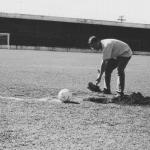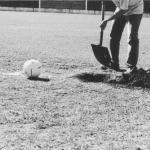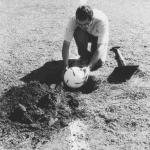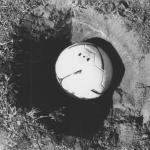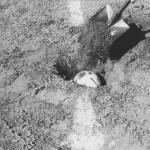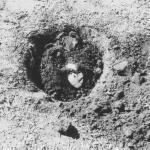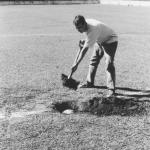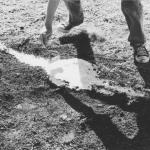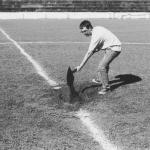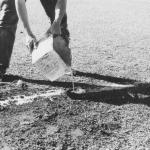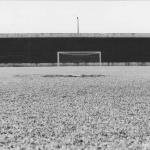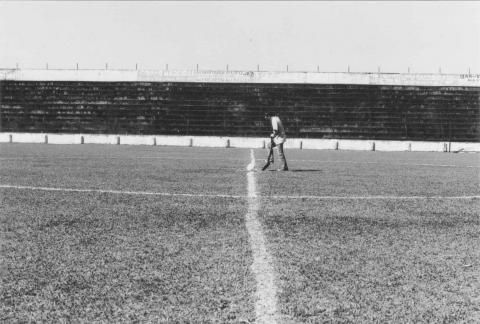Text by: Victor Da Rosa
AGAINST FOOTBALL
Final Tackling (Final result) the performance that Nuno Ramos made in 2007, documented by Sandra Antunes Ramos in 14 black and white photos, seems like a vengeance against football, perhaps an accusation. If football is a game open to possibilities, where the slightest contingency may alter the whole dramatic structure - it can often be a game of injustice, therefore, as suggested by Nuno himself in some of his essays, published in Ensaio Geral -, the photographs of Final Tackling function as a negative of this idea: the game is aimed at a radical immobility. There will be no ritual, surprise, nothing. Could it also be a symptom of our history? In fact, football has never seemed so much a game for a tie. In addition, there is some irony in the title -as well as in the linearity of the photographs, which also affirms and emphasizes clearly this need to affirm, eliminating any possibility of opening. To sum up, the movement imposed by the Final Tackling is connected to a certain investment of time. To the extent that the ball is buried right in the material and symbolic space that alludes to the start of the match - the circular lime mark in the middle of the field - the image of the Final Tackling constitutes a direct paradox: what should be the opening is now the closing of the end.
Final result (project for a football field). Unpublished work, 2007, that took place in the Virgilio Ferreira Jorge stadium, Orlândia, SP. Materials: ball, shovel and lime. Photographs by Sandra Antunes Ramos.
CONTRA FUTBOL
Placar final, (Resultado final) la performance que Nuno Ramos realiza en 2007, registrada por Sandra Antunes Ramos en 14 fotografías en blanco y negro, parece una revancha contra el fútbol, tal vez una acusación. Si el fútbol es un partido abierto de posibilidades, donde la menor contingencia puede alterar toda una estructura dramática - muchas veces es también el juego de la injusticia, por tanto, como sugiere el propio Nuno en algunos de sus ensayos, publicados en Ensaio Geral - las fotografías de Placar final funcionan como negativo de esta idea: el juego está destinado a una radical inmovilidad. No habrá ritual, sorpresa, nada. Sería, además, síntoma de nuestra historia? De hecho, el fútbol nunca se ha parecido tanto un partido destinado al empate. Además, hay cierta ironía en el título - e incluso en la linealidad de las fotografías, que afirma y además enfatiza la claridad de querer afirmar, eliminando cualquier posibilidad de apertura. El movimiento que Placar final impone está conectado, en resumen, a cierta inversión del tiempo. En la medida en que la pelota es enterrada exactamente en el espacio material y simbólico que alude al inicio del partido - la marca circular de cal en el medio del campo - la imagen de Placar final constituye una paradoja directa: lo que debería ser la apertura del comienzo ahora es el encierro del fin.
Resultado final (proyecto para un campo de fútbol). Trabajo inédito, 2007, realizado en el estadio Virgílio Ferreira Jorge, Orlândia, SP. Materiales: pelota, pala y cal. Fotografías de Sandra Antunes Ramos.
CONTRA O FUTEBOL
Placar final, performance que Nuno Ramos realiza em 2007, registrada por Sandra Antunes Ramos em 14 fotografias em branco e preto, parece uma revanche contra o futebol, talvez uma acusação. Se o futebol é o jogo aberto das possibilidades, onde a menor contigência pode alterar toda uma estrutura dramática - muitas vezes é também o jogo da injustiça, portanto, como sugere o próprio Nuno em alguns de seus ensaios, publicados em Ensaio Geral - as fotografias de Placar Final funcionam como negativo desta idéia: o jogo está destinado a uma radical imobilidade. Não haverá ritual, surpresa, nada. Seria, aliás, sintoma de nossa história? De fato, o futebol jamais pareceu tanto com um jogo destinado ao empate. Depois, há certa ironia no título - e mesmo na linearidade das fotografias, que afirma e ainda enfatiza a clareza do quer afirmar, cercando qualquer possibilidade de abertura. O movimento que Placar Final impõe está ligado, enfim, a certa inversão do tempo. Na medida em que a bola é enterrada exatamente no espaço material e simbólico que alude ao início do jogo - a marca circular da cal no meio de campo - a imagem de Placar final constitui um paradoxo direto: o que devia ser a abertura do começo agora é o fechamanto do fim.
Placar final (projeto para um campo de futebol). Trabalho inédito, 2007, realizado no estádio Virgílio Ferreira Jorge, Orlândia, SP. Materiais: bola, pá e cal. Fotografias de Sandra Antunes Ramos.
ΚΑΤΑ ΤΟΥ ΠΟΔΟΣΦΑΙΡΟΥ
Το Τελικό Μαρκάρισμα (Τελικό αποτέλεσμα), μια performance που πραγματοποίησε ο Nuno Ramos το 2007, την οποία κατέγραψε η Sandra Antunes Ramos σε 14 ασπρόμαυρες φωτογραφίες, μοιάζει σαν μια εκδίκηση κατά του ποδοσφαίρου, ίσως μια κατηγορία. Αν το ποδόσφαιρο είναι ένα παιχνίδι ανοιχτό στις πιθανότητες, όπου και το παραμικρό απρόοπτο μπορεί να μεταβάλλει την όλη δραματική σύνθεση - μπορεί συνεπώς να είναι συχνά ένα παιχνίδι αδικίας, όπως υπονοεί ο Nuno σε ορισμένα από τα δοκίμιά του, που περιλαμβάνονται στην έκδοση Ensaio Geral -, οι φωτογραφίες του Τελικού Μαρκαρίσματος λειτουργούν ως το αρνητικό αυτής της ιδέας: το παιχνίδι στοχεύει σε μια ολοσχερή ακινησία. Δε θα υπάρξει ούτε τελετουργία, ούτε έκπληξη, τίποτα. Θα μπορούσε να είναι σύμπτωμα της ιστορίας; Για την ακρίβεια, το ποδόσφαιρο ποτέ δεν υπήρξε φτιαγμένο για ισοπαλία. Επιπλέον, υπάρχει κάποια ειρωνεία στον τίτλο -καθώς και στη γραμμικότητα των φωτογραφιών, που λειτουργεί ως ανοιχτή επιβεβαίωση, απαλείφοντας κάθε πιθανότητα έναρξης. Τέλος, η κίνηση που επιβάλλεται από το Τελικό Μαρκάρισμα είναι συνδεδεμένη με κάποια επένδυση χρόνου. Εφόσον η μπάλα θάβεται ακριβώς στο πραγματικό και συμβολικό σημείο που υποδηλώνει την έναρξη του αγώνα - το κυκλικό σημάδι από ασβέστη στο κέντρο του γηπέδου - η εικόνα του Τελικού Μαρκαρίσματος αποτελεί ένα ανοιχτό παράδοξο: αυτό που θα έπρεπε να είναι η έναρξη, είναι τώρα το κλείσιμο του τέλους.
Τελικό αποτέλεσμα (project για γήπεδο ποδοσφαίρου). Ανέκδοτο έργο, 2007, που έλαβε χώρα στο στάδιο Virgilio Ferreira Jorge, Orlândia, Σάο Πάολο. Υλικά: μπάλα, φτυάρι και ασβέστης. Φωτογραφίες: Sandra Antunes Ramos.



